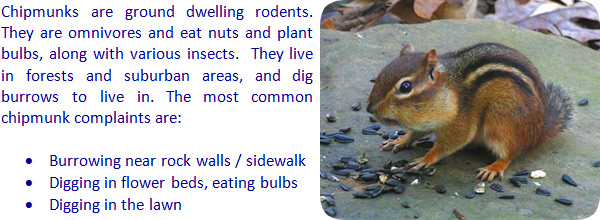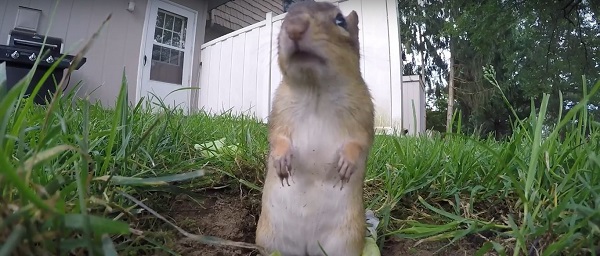 If you need help, click on my Nationwide List of Chipmunk Removal Experts for a pro near you.
If you need help, click on my Nationwide List of Chipmunk Removal Experts for a pro near you.
Chipmunks are highly adaptive nuisance animals found in most of the 50 American states. They eat a wide variety of foods and are harder to bait and trap than most rodents such as voles, mice, and rats. Trapping is suggested as the most effective way to reduce chipmunk populations, which are based on twice annually breeding cycles that cause them to grow quickly once an adequate food source has been secured.
The best strategy for chipmunk control is prevention. Coyote urine is a natural repellent commercially available in select locations. The internet is your best source for information on using this form of repellent that is considered the most effective. Coyotes are at the top of the food chain as chipmunk predators. Chipmunks will avoid any territories marked with coyote urine. Consult coyote urine experts for application and rate instructions.

Killing chipmunks is necessary when there is an infestation of chipmunks and the population is feeding on your electrical wiring, materials in your garage, and invading home food stores. A frequent sign of chipmunk infestation is after the home and outbuildings have been treated for rats and mice; but, there are still signs of break-ins by rodent type creatures. The reason is simple- chipmunks eat differently with more variety than common rodents. And they will ignore the bait that is used to attract their cousins to their doom.
Trapping is considered by many pros to be the best method for reducing the chipmunk population over time. Once the chipmunk population has established itself in its burrows as much as 40 feet beneath the ground, it is a long hard slog to thin them out when they come up to feed. Well-placed, properly-baited traps can ensure that once the feeding adults come up to gather grub for the family, they will be unlikely to return home.
Chipmunk traps are simple devices. These traps lure the animal into the entrance with a preliminary snack of nuts or seeds set in pecan paste. A slight scent trail is made using the pecan paste to lure the animal into the center section of the rectangular trap. In the center section is the “trip pan” which is where you want the animal to place its full weight by stepping on it. Placing more food on the trip pan will allow the animal to feed while spotting further inside the trap on the trap’s back plate, still more food. The final location motivates the animal to step on the trip pan and that will spring the trap, trapping the animal. When feeding off of the trip pan the animal can always leave after eating. However, proper baiting will motivate the animal to step on the trip pan en route to more delicious food.
Once, trapped the animal can be released back into the wild. However, caution must be exercised in choosing release locations. Chipmunks are avid travelers and will travel distances of up to two miles in order to return home. A distance of five miles is suggested to encourage the animals to find new surroundings for starting a family.
Lethal traps are one of several ways to kill chipmunks. Poisoned bait and lure traps are popular. However, many chipmunk foes make the mistake of confusing chipmunks with other common rodents. This is a mistake that will result in empty traps- lethal and non-lethal traps alike.
Chipmunks like a variety of tasty foods. They have a refined sense of taste more so than rodents like mice and rats. Mice and rats cannot detect the taste of poison or other unpleasant substances. Chipmunks can. So if baiting the chipmunk trap, the liquid poison to be used should be mixed in with something that chipmunks cannot resist.
Chipmunks cannot resist a commercial product known as “pecan paste”. It is a mix of oils, sugars and nuts that chipmunks love. Mixing liquid poison in a full supply of pecan paste will bait many traps. One can also mix large batches and place inside sandwich bags to be tossed down a chipmunk hole to take out three to five chipmunks at a time. Caution should be used when baiting the traps not to leave poisoned droppings around the trap for non-target animals to consume and become sick.